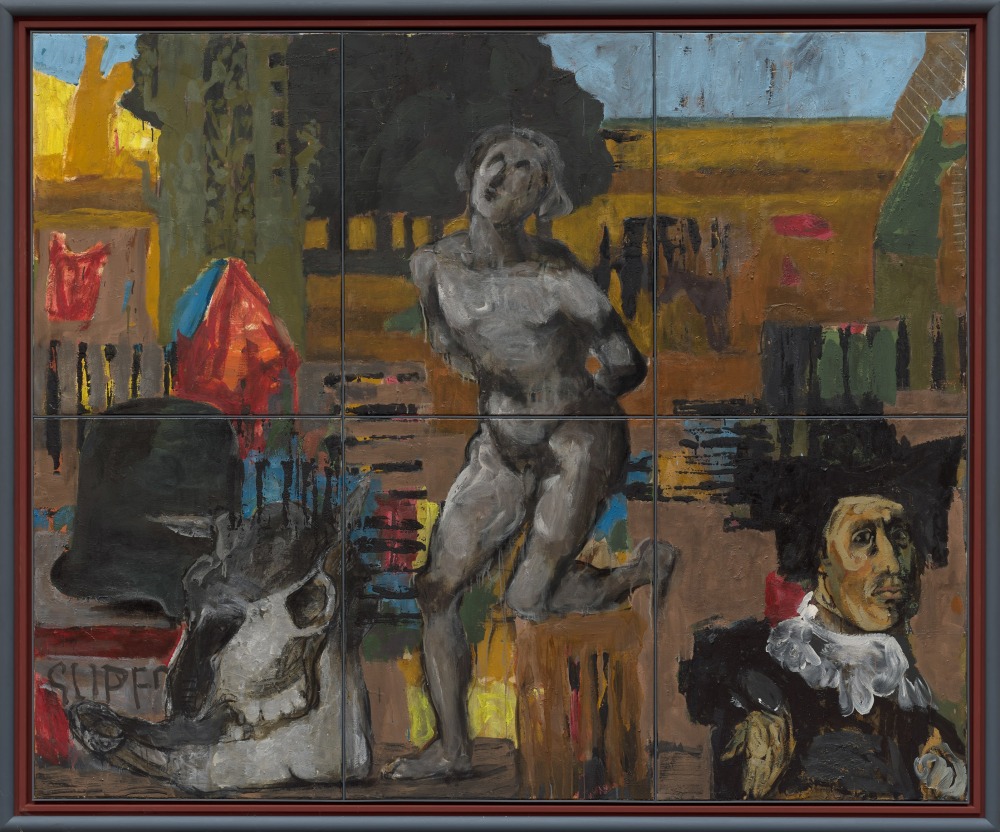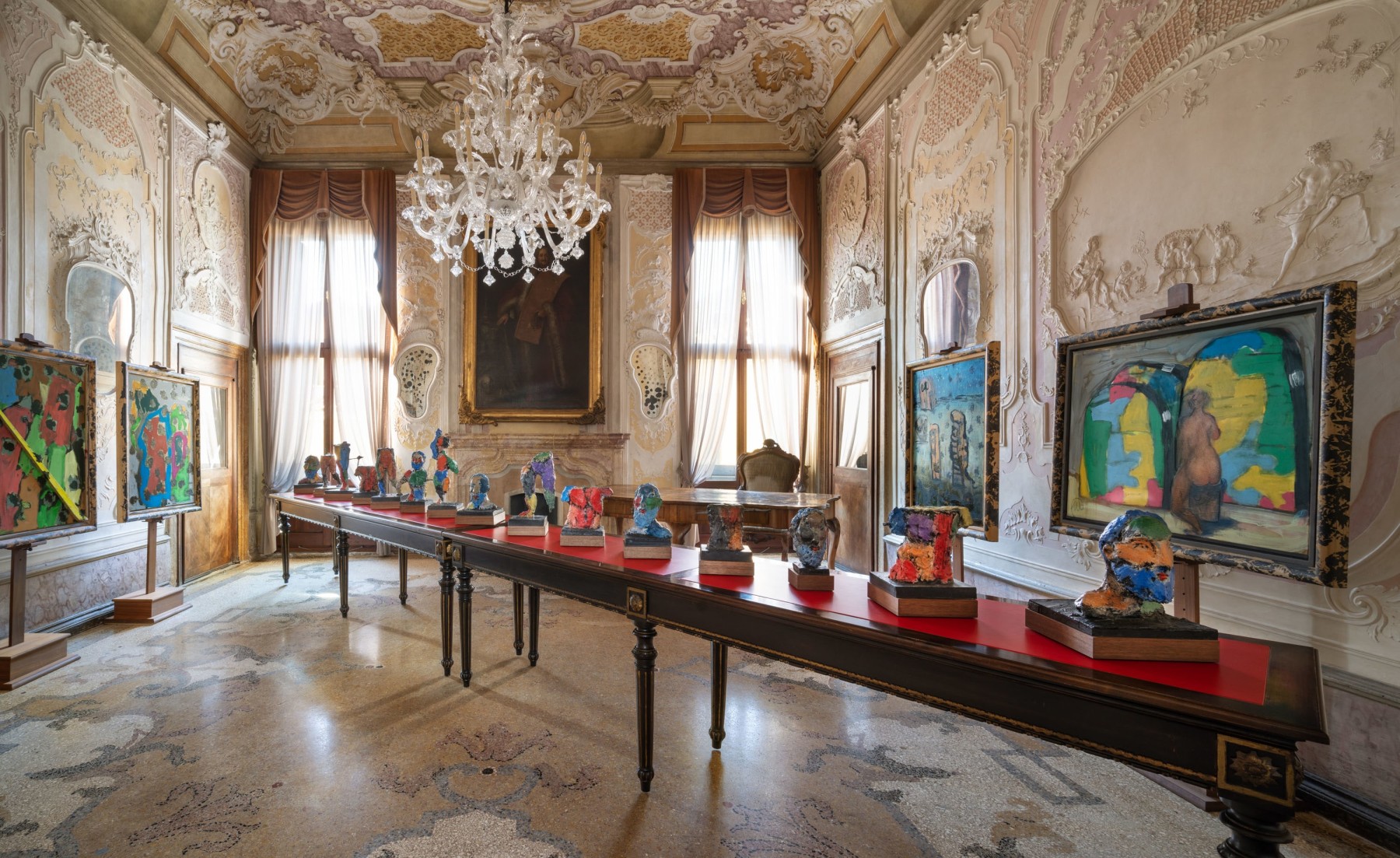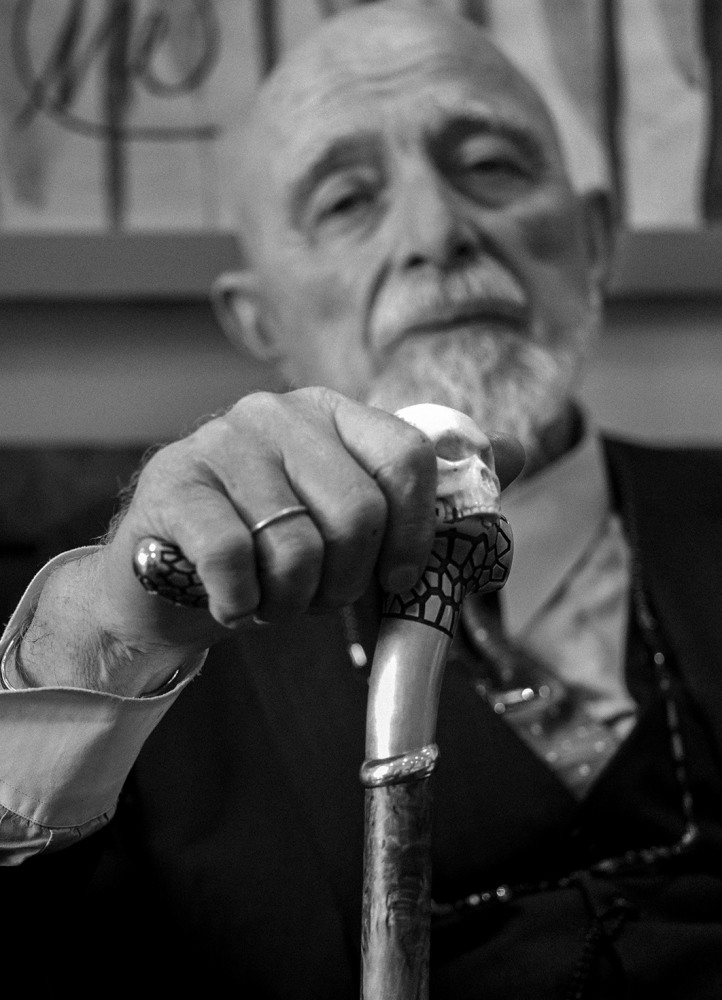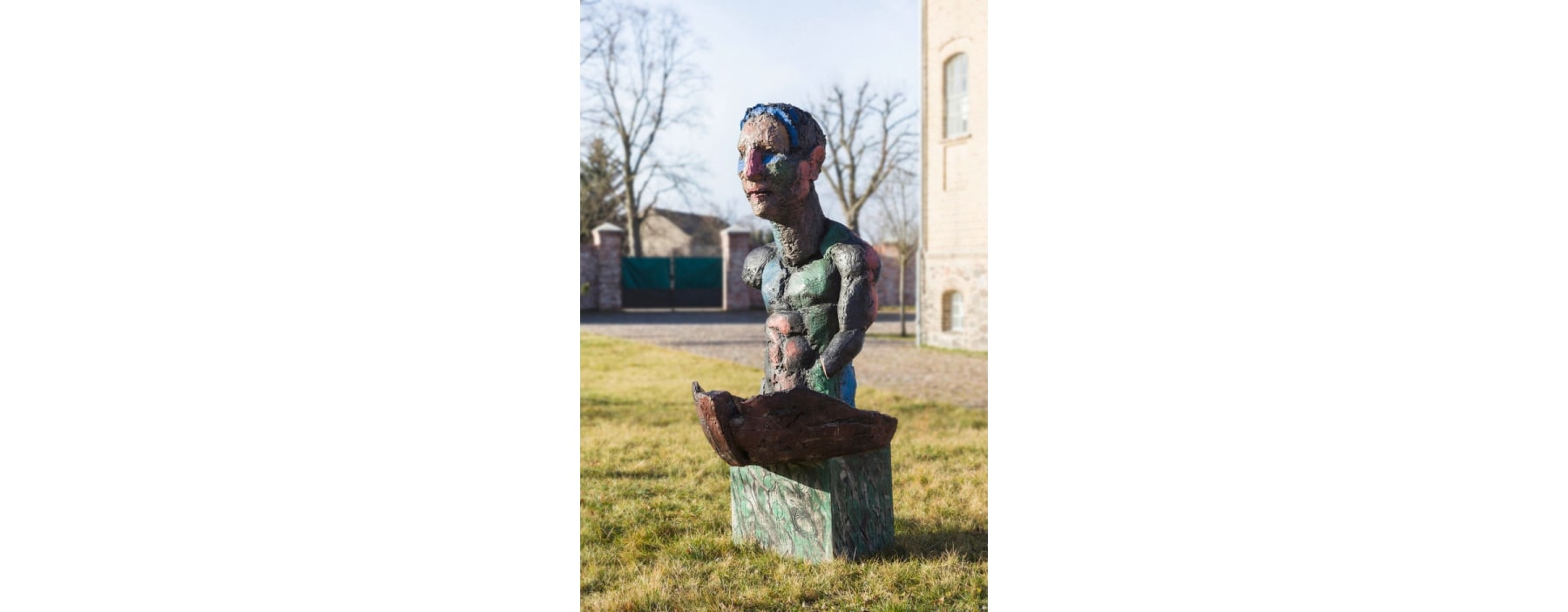
Markus Lüpertz, “Sebastian”, 2020
Istituto Veneto di Scienze, Lettere ed Arti, Venice, with the support of Michael Werner Gallery is pleased to present Markus Lüpertz: Palazzo Loredan, an exhibition of recent paintings and sculptures by the iconic German artist Markus Lüpertz (b. 1941, Liberec, Bohemia).
The ornate libraries and halls of the extraordinary Palazzo Loredan on Campo Santo Stefano provide a unique and unexpected environment to view the artist’s works.
One of the most important and influential contemporary artists in post-war Europe, Lüpertz has continually engaged in a critical dialogue with painters of the past. The artist has said, “I live with artists I routinely retrieve from the recesses of history, and then they become part of my everyday life, they are my companions, they exist for me. I deal with them as if they were alive.”
Evoking figures from the paintings of Rubens, Poussin, David, Puvis de Chavannes, Courbet, Manet, and others and placing them in contemporary settings, Lüpertz creates art that is entirely new. The artist elaborates, “Today, avant-gardism has become a credo with its own rituals. I thrive to move past that and define something new and unique. For this I often look back at Old Masters. Influences I navigate between in order to arrive at a very specific visual language, a visual language of our time.”
Lüpertz’s new work pulls from art history, exploring the biblical stories of Cain and Abel, Adam and Eve, and St. Sebastian as well as the ancient myth of Dionysus. Aside from investigating traditional subjects, the artist reinterprets philosophic and introspective historic artistic impulses including allegory, mortality, and the idyllic utopia of Arcadia.

Palazzo Loredan

Markus Lüpertz, Photo by Yaël Temminck
"The artist’s place is doubtless today among the greatest, but Lüpertz is also the one who summons forth an unpainted painting. The one who is in thrall to a passion for an art he does not know and which he intends to confront as though it existed. He believes in that which makes us available for an experience without which culture would be a dead end, an entertainment for a society having lost the words to recognize art as such. As long as an artist can be liked without needing to be understood, a hope of renewal exists so that it need not be like that. With the weapons of poetry, he summons forth another perfection, which he sees today, more than ever, can only be found after having been profaned and destroyed. It is, they say, with Rabelais in his bag that the youthful Markus set off for Paris one day, so that there might light up within him a possible world, the one he would like, so that everything could start over, to provide an idea, and even more than an idea, a conviction. Everything is a beginning in his painting, everything is a departure. There is never any going back in art, only a few odysseys that are destined to be the best we can hope for."
- Eric Darragon
Markus the Painter: Abstraction & Bohemia
Eric Darragon
Those seeking in art the conviction of certainty, and those attracted to and seduced by the adventurousness of the unknown, will find in Markus Lüpertz’s oeuvre a wealth of material, but in an unstable, contrasting state, simultaneously dark and light, which, in varying degrees, will oblige some to share in the experience of others, in an endless attraction of opposites. This approach, which has endured over time, made possible from the outset the existence of a kind of sovereign hieroglyph, called, after Nietzsche, a dithyramb. This hiero-glyph, as a result of some unknown mystery, has exerted an enduring influence over an actuality that the artist has never really adapted to. No more today than yesterday, no more in Beuys’s time than in that of Duchamp. Odysseus II, a sculpture created in 2014, and Ulysses II, a painting from 2011, put forward the most significant figures of this story, which started with a strange imprint, that of a physical world entirely subjected to a preconceived modular form: be it the clay of a painting like Schuhabdruck – dithyrambisch [Shoeprint – dithyrambic] in 1965, the concrete of Westwall [West Wall], the wood in Telegraphenmasten – dithyrambisch [Telegraph Poles – dithyrambic] in 1968. Painting and nothing else on the surface of a deserted land.
In theory, a retrospective proceeds from a selection, but this one sets out to refute the idea that a selection would make it possible to eliminate or conceal the risk involved or the uncertainty specifically linked to an art that sets out to avoid being confused with interpretation and exists only in accordance with itself. In those conditions, nothing can be set aside a priori. It has been said of the artist that he shares the chameleon’s ability when it comes to appearance and apparition. Did we not see him recently with a green lizard as a decoration? Is he not forever asked the same questions? Is he not the one who answers them? That would mean being unaware of another fact, another coherence, in which the passage of years makes us aware to what extent they partake of an enigma and of a subterranean yet powerful permanence. We will here attempt to propose a certain idea, not at the cost of a stylistic continuity, which the artist has always, truth to tell, defied, but according to the logic of a“fragmentarismus” that calls into question the ascendancy of the concepts or the consistency of the subjects on the very notion of the symbol which has, from the very outset, haunted forms seeking the absolute. The Dachpfannen [Roof Tiles] from 1967 were one of its most precocious and astonishing manifestations. The dissidence of the 1976 poem “Do not die with the problems of your times” contained a challenge that the contemporary period has only intensified with the generalized reign of an avant-gardism, to which it is reproached that it is only a philistine’s response to self-generated problems.

Markus Lüpertz
"Odysseus II", 2014
Bronze
From an edition of 6 + 1 AP
Each hand-painted
94 x 32 1/4 x 53 1/4 inches
239 x 82 x 135 cm
The distance taken with the mainstream of his times enables the artist to proclaim fearlessly: “I am a pure product of my own self.” A manner of summoning an art that owes its substance only to the individual and to him alone. An art that affirms an independence that we thought never to know again when the sculptor, in everyone’s eyes, in Germany or elsewhere, placed on a base a more or less naked sculpture that turned out to be the figure of a god, of a goddess, of a hero, sometimes dismembered. The blind indecency of a mythology intent on provoking the clichés of modernism and the canons of everlasting beauty. A way of summoning up an unknown story, that to which for centuries artists have given shape, including the greatest of them, those whose works are only known by means of copies. An art deliberately constructed on an entirely artificial basis, the only one that made up history and civilization. “It is through the voice of one crying in the wilderness that the ways of the gods must be prepared.” Markus the painter, as he often describes himself, gives this sentence by Oscar Wilde a new resonance. His polychrome gods would not be understood without the wilderness to which they address themselves and from which, paradoxically, they spring forth like Mozart in Salzburg or Hölderlin in London. They are less the idols of a resistible restoration of values than the fragments in a wild state of an abstract ideal. The landscapes that he started to paint in 2011 like a single Arcadia are nothing other than the territory of a more profound abstraction whose aim can be recognized thanks to other signs and other conditions. The artist’s place is doubtless today among the greatest, but Lüpertz is also the one who sum-mons forth an unpainted painting. The one who is in thrall to a passion for an art he does not know and which he intends to confront as though it existed. He believes in that which makes us available for an experience without which culture would be a dead end, an entertainment for a society having lost the words to recognize art as such. As long as an artist can be liked without needing to be understood, a hope of renewal exists so that it need not be like that. With the weapons of poetry, he summons forth another perfection, which he sees today, more than ever, can only be found after having been profaned and destroyed. It is, they say, with Rabelais in his bag that the youthful Markus set off for Paris one day, so that there might light up within him a possible world, the one he would like, so that everything could start over, to provide an idea, and even more than an idea, a conviction. Everything is a beginning in his painting, everything is a departure. There is never any going back in art, only a few odysseys that are destined to be the best we can hope for.
“Take care, Max is not exactly my first name, it is a particle.” What Max Jacob claimed derisively, Lüpertz says in his own way because he spent time earlier in the Benedictine abbey of Maria Laach, because he worked in a coal mine, because he took part in the associative gallery Großgörschen 35, in Berlin and because for all those who knew him, he was always Markus and he never ceased being that by signing his first paintings with his first name, like some of his colleagues before him, in other times. A half century of artistic bohemia later on, he introduces himself as what he is: a painter, which is a way of signifying something evident that is not obvious. An exhibition that opens directly with the most recent works implies discovering in fine the early years both as an unsuspected departure point and a possible beginning. The dithyramb then appears as a desire to paint whose works reiterate the invocation, more than they carry out the program. The painter does not deny time’s irreversible experience, but he does not confuse it with the steps of a change. “Change,” he declared, “is only an illegitimate professionalization of painting.” The various series, which mark the most clear-cut shifts in his oeuvre, the most risky resumptions, the clearest affirmations, are also concerned with the danger of what he calls “professionalization.” One of the principles of this “art that provides rules,” to use his expression, expresses it pretty much as it was understood by Delacroix and Picasso in their time: “One must be careful while painting not to learn how to paint.” The opportunity we are given to go back, so to speak, over the artist’s steps, invites us to consider what he did not see while he painted his “programmatic” canvases, i.e. blind to what they already contained. In this respect, the impressive series of Rückenakte [Nudes from the Back], dating from 2004 to 2006, a genuine manifesto of a painter’s life, implies emphatically that paint is linked to the visible via the invisible and it cannot express what it is without envisaging what it does not know. To see a painting, then, is to share in an adventure which was that of the inventors of abstraction, that of the Romantics and of Caspar David Friedrich in particular.
Between a Homeric figure like Achilles turned in 2014 toward an unknown horizon and a painting from 1966 drawn up like a mast against an implacable azure blue (Segel [Sail]), the distance could seem to be as significant as the proximity. From this it would be easy to incriminate the two fetishes sup-posed to separate modern art: the abstract and the figurative. We would quickly come to realize that these notions are unsuited to describing artworks separated by a lifetime of work. From the very start, the adjective “dithyrambic” took on the aspect not only of a banal object but also that of a monumental certainty from elsewhere. His abstraction is inscribed through geometry in the concrete form, the most identifiable there is, but also the least foreseeable. After Barnett Newman’s red, yellow, and blue, who could be afraid of an asparagus field or of the Siegfried line? On the contrary, Achilles is a rough sculpture removed from everything that might concern us. A form taken from the Greeks, without the academic pretext of Nature, nor even that of History, fated to be seen today as if everything had not already been said of the classical tradition; as if nothing was opposed to such an apparition, as if the risk of being judged by the criteria that would make such a figure illegitimate, as they like to say, did not exist. Lüpertz does not hear anything of what his contemporaries’ opinions proclaim. With their calm irony and their casualness, the Tents had no more the pretention of representing, in 1965, the Acheans’ camp than that of celebrating the leisures of the Federal Republic under Konrad Adenauer. Achilles no more seeks the justification of a Neue Typ walking in the steps of Arno Breker or of Polycletes. We must therefore resign ourselves to consider that the most widely acknowledged cultural categories only lead to incongruities and, from there onward, one must find one’s own path.
The painter addresses us like Montaigne addresses the reader of the Essais or Nietzsche, the author of Menschliches, Allzumenschliches, his German compatriots. He assumes in each one an availability that he intends to carry out freely by means of the thousands of possibilities that, for him, are those of creation. He intends to set in motion a society that can be reborn thanks to the call of an art form whose only aim is to make visible the incomprehensible. So many potential choices and forms explain the diversity of a body of work hard to contain even at the core of its apparent contradictions, on condition we notice that this impatience with any control, this fear of a necessary dis-order are in the service of an obsessive idea, that of a unique oeuvre, valid for whatever subject.“ I want to invent the prototypes of a painting capable of il-lustrating any subject,” a declaration that allows us to understand the admi-ration that the artist feels for a painter like Mondrian, even though the history of Neo-Plasticism is diametrically opposed to his own. The indomitable painting, exasperated by its own identity as can be seen in the series Männer ohne Frauen. Parsifal [Men without Women. Parsifal] (1993–1997), sometimes manages, at the very core of his enthusiasm and of his fervor, to arrive at a form of emblem, with all the characters of a lucid analysis of what obscurely worries him. Poussin – Philosoph [Poussin – Philosopher] (1990) combines, by means of a partition line, a dark and leaden background, obscured by mechanical monsters in the manner of Max Ernst, with the sublime world of Paysage avec Saint Jean Patmos [Landscape with St. John on Patmos] (1640). What might have seemed to be the breaking-up of a lost unity can also be seen as a horizon in a world overcome by its fears. The painter’s vision is not content with opposing two forms of ruins, in heaven as on earth, it conceives, based on the antique confrontation of humanity’s ages ante gratiam and sub gratia, a new notion of reason and of unreason. Around the same time, in 1989, another painting recalls, via primary colors in layers, the famous modernist square from which emerge, on a blazing background, creatures that a character, also taken from Poussin, appears to justify. That character, the Nar-cissus in the painting in the Louvre (Écho et Narcisse [Echo and Narcissus] 1628) that the artist often used as inspiration, particularly for his Prometheus, inhabits various levels of the pictorial illusion and contradicts, as in a satirical drawing by Hogarth, the principle of Neo-Plasticist equilibrium.
The aesthetic purism linked to Poussin and Mondrian seems concerned by a conflict that distorts both. Der Schlaf/Prometeo (nach Poussin) [Sleep/Prometheus (after Poussin)] is an appeal to overcome the deadly work of Chronos. “We, the artists, we are the children of the night, not of sleep” : this statement by the artist is not an isolated phenomenon; we can find it in other aspects in 1973, in the series Palette, the paintings Tod und Maler I – dithyrambisch [Death and Painter I – dithyrambic] VII, Eskalation – dithyrambisch [Escalation – dithyrambic] VIII, which combine, in addition to flexible elements like electric posts, railroad tracks, anti-tank defenses, tree trunks, new attributes of the expressive shape, including snail shells which appear to be the generating principle. With its exuberance and its logic, Eskalation – dithyrambisch responds to a state of consciousness capable of evoking the triptych of 1910, Evolution, by Mondrian. Even if Lüpertz does not conceive the “spiritual” in the same terms as Mondrian, the paint is here juxtaposed with the complementary poles of the organic and of the inorganic as Samuel Beckett liked to say (admittedly about the Fêtes galantes by Watteau). In the early 1960s, be-fore starting on his dithyrambs, the young artist was interested in the visionary architecture of the Gläserne Kette, highlighted in a recent study as well as by an exhibition devoted to Bruno Taut in 1962 in Berlin. Earlier, he had gone to Dornach, near Basel, to visit Rudolf Steiner’s Goetheanum. The form he adopted in 1964 for Mexikanische Dithyrambe [Mexican Dithyramb] and Dithyrambe – schwebend [Dithyramb II – Floating] retains a symmetrical plasticity, between molding and architectural modules, which painting propelled into a dimension freed from any doctrinal weightiness. Like a UFO endowed with existential humors, the protean structure is modified, plays with its insistence, sometimes takes on Harlequin’s costumes, becomes the support for arbitrary designs. In parallel, the drawing explores, in keeping with the same principle, a rhythm that is close to the ductus of a spiritual exercise. Speculation and analysis go hand in hand with the invention of a form without any definitive content, despite being, through its origins, previously saturated with it. With the breadth of an inspiration that intends to thwart interpretation, a process is developed that, every time, requires the renewal of the fundamentals of form, of line, of shape, of color.
The series Stil from 1977 subjects them to a simultaneously mocking and serious ordeal, as is indicated in Mädchen in Betrachtung einer Hauswand [Girl Watching the Wall of a House]. To follow its vagaries would be akin to visiting, at great speed, the studios of abstraction—those of Paul Klee, Ernst Wilhelm Nay, Asger Jorn and Constant—but with no other gain than that of a happy and naive confusion. Furthermore, akin to looking, again, at the earlier paintings in the light of a new idea of composition that had reached its peak in 1975 with the architecture of the series Babylon, inscribing, in an optimistic polyphony, black monograms destined for the sky. The hidden face of a Suprematist utopia? An above-ground Lüpolis as enigmatic as a railroad in the Ruhr? That sky has temporarily vanished; on the canvas, the surface is struggling to remove itself from the objects’ disparate hold, from that of the styles and techniques that render painting elusive, especially when it takes on the posture of an ontological querying (3 Bilder zur Erschaffung der Erde [3 Paintings on the Creation of the Earth], 1977). Without the test of everything that can dissolve, threaten, or lose it, we could not grasp the energy it is capable of for discovering itself, starting from everything as well as from nothing. Its frenzy destroys as much as it builds up the exile of which a bohemian perfection boasts.
Discovering the series Arkadien [Arcadias] —paintings in which the figures have the consistency of sculptures, whose mythology only exists in the form of fragments, whose landscape repeats a usual outline, in a format that is a deliberate return to that of the paintings in an art lover’s curiosity cabinet—simultaneously presupposes knowledge of and ignorance of the painting of the century of Courbet. Before mentioning elements that find their logic herein, one must accept, in 2014 as a century ago, the ordeal of a classicizing disavowal with which Picasso, de Chirico and Picabia played with a disconcerting daring. The current period is different: the art world is fragmented and the confrontation between various practices no longer has any meaning. Here, the artist is having a dialogue with a vanished world: that of old painting. Even if that world has not entirely vanished, how can we fail to see that it survives thanks to the virulent debates it inspired, for example in the Italy of Futurism, in the France of a return to order, in the Germany of the Neue Sachlichkeit, as in the world of Tachism, of Pop Art or of Arte Povera. The Arcadia whose frontiers intermingle with those of classical art is not for the creator of the 5 Bilder über das mykenische Lächeln [5 Paintings on the Mycenaean Smile] an umpteenth dream of harmony or of social utopia. Therein, the painter does not include any golden age, no joie de vivre, nor invitation to a journey.